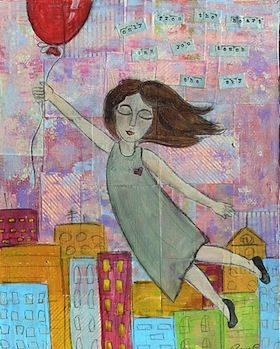
Last year on this day, I got fired. That was a real pleasant Groundhog Day. I was so confused by what had happened that I drove around the D.C. beltway twice. I missed my exit, and realized that halfway around the second time.
I just thought on this day, you could probably use some winter depression busters, too, although I know I published them last month.
Let’s call a spade a spade: winter sucks for some of us. So, little marmot, I don’t care what you do. I don’t care if you get yourself a nice rat for dinner, I’m sticking to these techniques regardless of whether the hairy little thing sees his shadow or not!
1. Watch the sugar.I think our body gets the cue just before Thanksgiving that it will be hibernating for a few months, so it needs to ingest everything edible in sight. And I’m convinced the snow somehow communicates to the human brain the need to consume every kind of chocolate available in the house. We are mammals, yes, so do we think we need an extra layer of fat in the winter to keep us warm? I’m starting to think so.
Depressives and addicts need to be especially careful with sweets because the addiction to sugar and white-flour products is very real and physiological, affecting the same biochemical systems in your body as other drugs like heroin. According to Kathleen DesMaisons, author of “Potatoes Not Prozac”: Your relationship to sweet things is operating on a cellular level. It is more powerful than you have realized….What you eat can have a huge effect on how you feel.”
2. Stock up on Omega-3’s.
During the winter I’m religious about stocking in my medicine cabinet a Noah’s Ark supply of Omega-3 capsules because leading physicians at Harvard Medical School confirmed the positive effects of this natural, anti-inflammatory molecule on emotional health. I treat my brain like royalty–hoping that it will be kind to me in return–so I fork over about $30 a month for the Mac Daddy of the Omega-3s, capsules that contain 70 percent EPA (Eicosapentaenoic acid). One 500mg softgel capsule meets the doctor-formulated 7:1 EPA to DHA ratio, needed to elevate and stabilize mood.
3. Give back.
Ghandi once wrote that “the best way to find yourself is to lose yourself in the service of others.” Positive psychologists like University of Pennsylvania’s Martin Seligman and Dan Baker, Ph.D., director of the Life Enhancement Program at Canyon Ranch, believe that a sense of purpose–committing oneself to a noble mission–and acts of altruism are strong antidotes to depression.
The winter months are a good time to do this because the need is greater, the holiday spirit ideally lasts until February, and you don’t have the excuse of attending family picnics, unless you live in California or Florida.
4. Join the gym.
Don’t let the cold weather be an excuse not to sweat. We have centers today called “gyms” where people exercise inside! Granted, it’s not the same–watching the news or listening to the soundtrack from “Rocky” as you run in place as opposed to jogging along wooded paths with a view of the bay. But you accomplish the goal: a heart rate over 140 beats a minute.
The gym is also a kind of support group for me. These women, I’m guessing, are going after the endorphin buzz just like me because alcohol and recreational drugs don’t do the trick anymore. And, like moi, I suspect that they also have great difficulty meditating. Every time they close their eyes, they have visions of screaming kids, Chuck E. Cheese hell, and the crisis of no thank-you gifts for teachers.
5. Use a light lamp.
Bright-light therapy–involving sitting in front of a fluorescent light box that delivers an intensity of 10,000 lux–can be as effect as antidepressant medication for mild and moderate depression and can yield substantial relief for Seasonal Affective Disorder.
I usually turn on my mammoth HappyLite in November, just after my least favorite day of the year: when Daylight Saving Time ends and we “fall back” an hour, which means that I have about an hour of sunlight to enjoy after I pick up the kids from school.
6. Wear bright colors.
I have no research supporting this theory, but I’m quite convinced there is a link between feeling optimistic and sporting bright colors. It’s in line with “faking it ’til you make it,” desperate attempts to trick your brain into thinking that it’s sunny and beautiful outside–time to celebrate Spring!–even though it’s a blizzard with sleet causing some major traffic jams.
Personally, I tend to wear black everyday in the winter. It’s supposed to make you look thinner. But the result is that I appear as if and feel like I’m going to a funeral every afternoon between the months of November and March. This isn’t good. Not for a person hardwired to stress and worry and get depressed when it’s cold. So I make a conscious effort to wear bright green, purple, blue, and pink, and sometimes–if I’m in a rush–all of them together!
7. Force yourself outside.
I realize that the last thing you want to do when it’s 20 degrees outside and the roads are slushy is to head outside for a leisurely stroll around the neighborhood. It’s much more fun to cuddle up with a good novel or make chocolate chip cookies and enjoy them with a hot cup of Jo.
On many winter days–especially in late January and early February when my brain is done with the darkness–I have to literally force myself outside, however brief. Because even on cloudy and overcast days, your mood can benefit from exposure to sunlight. Midday light, especially, provides Vitamin D to help boost your limbic system, the emotional center of the brain. And there is something so healing about connecting with nature, even if it’s covered in snow.
8. Hang out with friends.
This seems like an obvious depression buster. Of course you get together with your buddies when your mood starts to go south. But that’s exactly when many of us tend to isolate. I believe that it takes a village to keep a person sane and happy. That’s why we need so many support groups today. People need to be validated and encouraged and inspired by persons on the same journey.
And with all the technology today, folks don’t even have to throw on their slippers to get to a support group. Online communities provide a village of friendship right at your computer. Every day I read comments like this one from Beyond Blue member Margaret: “Membership in this club to which we all unwillingly belong isn’t something I would wish on anyone; nonetheless, reading how others have survived specific circumstances has given me hope where I’d lost sight of it and inspired me to keep on keepin’ on even when my feet feel as if they’re encased in buckets of cement and will pull me under the stagnant water in the bottom of the pit.”
9. Head south.
Granted, this solution isn’t free, especially if you live in Maine. But you need not travel like the Kennedys to transplant your body and mind to a sunny spot for a few days. I try to schedule our yearly vacation the last week of January or the first week of February so that it breaks up the winter and so that I have something to look forward to in those depressing weeks following the holidays.
10. Take up a project.
There’s no time like winter to start a home project, like de-cluttering the house or purging all the old clothes in your kids’ closets. When a friend of mine was going through a tough time, she painted her entire house–every room downstairs with two different colors. And it looked professional! Not only did it help distract her from her problems, but it provided her with a sense of accomplishment that she desperately needed those months, something to feel good about as she saw other things crumble around her. Projects like organizing bookshelves, shredding old tax returns, and cleaning out the garage are perfect activities for the dreary months of the year. And hey, most of them are free!
11. Challenge yourself.
My mood can often be lifted by meeting a new challenge–an activity that is formidable enough to keep my attention, but easy enough to do when my brain is muddied. Learning how to record and edit video blogs, for this girl who hates technology, turned out to be great fun. Friends of mine get the same boost by joining Jenny Craig and losing the 25 pounds of baby fat, or exploring a new hobby–like scrapbooking. I try to stretch myself in a small way every winter–whether it be taking a writing class, researching the genetics of mood disorders, or trying to build myself a website. It keeps my brain from freezing, like the rest of my body.
12. Light a candle.
If I counted up all the minutes I’ve spent staring into a flame, I wonder how many years of my life that would be. Certainly more than the hours I’ve spent brushing my teeth or combing my hair. It would probably even surpass the combination of bath and shower time.
For some reason I assume God hears me better if I stick my face in a hot glowing body of flame. The scarlet blaze generates a feeling of hope, of fierce tenacity, that whispers: “you’re not off the hook yet…hang in there.”

